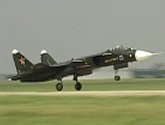
 After stealing
dozens air shows and breaking thousands hearts, Sukhoi had established
as a world known aircraft design bureau, beating a rival Mikoyan
after decades of bad luck and political opposition. Sukhoi's
workhorse, basic Su-27 had
been rebuild as the Su-30 interceptor,
Su-33 carrier born fighter, Su-34
tactical bomber, Su-32FN ASW and coastal defence platform, Su-35 and Su-37 air-superiority
fighters. However, busy with development of the Su-27,
Sukhoi is working on at least two fighter-sized aircraft, one
of which is intended to replace Su-27,
Su-33, Su-35 and Su-37.
After stealing
dozens air shows and breaking thousands hearts, Sukhoi had established
as a world known aircraft design bureau, beating a rival Mikoyan
after decades of bad luck and political opposition. Sukhoi's
workhorse, basic Su-27 had
been rebuild as the Su-30 interceptor,
Su-33 carrier born fighter, Su-34
tactical bomber, Su-32FN ASW and coastal defence platform, Su-35 and Su-37 air-superiority
fighters. However, busy with development of the Su-27,
Sukhoi is working on at least two fighter-sized aircraft, one
of which is intended to replace Su-27,
Su-33, Su-35 and Su-37.
The final configuration of the new generation fighter was revealed at enlarged meeting of the Russian air force Military Council (RusAF MC) which was held on 31 January and 1 February of 1996. It is hard to say if chief editor - Sergei Skrynnikov - was aware of the healthy curiosity of western aircraft enthusiasts to fifth-generation Russian fighters, whose focus was mainly attracted to the scale model sitting at the desk in front of Glavcom VVS (RusAF commander) Piotr Deinekin and Sukhoi constructor general Mikhail Simonov . The type is believed to be new air-superiority fighter referred by west as S-37 (formally known as S-32 -- do not mix with Su-32!).
Although the S-37 was expected to be unveiled at Moscow Aerospace salon (MAKS'97) along with Mikoyan's 1.42, both remained wrapped in veils of secrecy due to decisions made by Russian military. Both MFI contenders were shown to Prime Minister Chernomyrdin at closing days of the air show.
The Sukhoi's vision of fifth-generation fighter is considered a lower cost solution (in a ballpark of $40 mln) for the MFI requirement than officially cancelled article 1.42. The savings from this slightly smaller, but equally sophisticated aircraft are believed to be due to the less radical and yet very capable design, demonstrating a mix of the fourth-and-a-half (4++) generation technologies and revolutionary new developments.
The S-37 might well be the latest and the last of Russia's
aerospace industry, owning its concept to the very final iterations
of fundamental aircraft research of former Soviet Union. The exact reasoning behind Sukhoi's decision
to pursue heavy fifth-generation fighter is not clear. As recently
stated by Russia's former Defence Minister Igor Sergeyev, currently
Russia develops six types of fighter aircraft. The funding from
RusAF remains scarce at best and the competition between ANTK
Sukhoi and MAPO MIG for this money is fierce. Clearly, the investment
of the capital gained from export sales of Su-27
to China and Su-30MKI to India in the S-37 project can serve
as a final blow to the MAPO MIG fighter business. If the S-37
will indeed turn out a cheaper MFI, Simonov can count on possible
orders from RusAF in very distant future. The S-37 can also have
a great export potential as the Su-27
replacement and compete with F-22
exports.
The exact reasoning behind Sukhoi's decision
to pursue heavy fifth-generation fighter is not clear. As recently
stated by Russia's former Defence Minister Igor Sergeyev, currently
Russia develops six types of fighter aircraft. The funding from
RusAF remains scarce at best and the competition between ANTK
Sukhoi and MAPO MIG for this money is fierce. Clearly, the investment
of the capital gained from export sales of Su-27
to China and Su-30MKI to India in the S-37 project can serve
as a final blow to the MAPO MIG fighter business. If the S-37
will indeed turn out a cheaper MFI, Simonov can count on possible
orders from RusAF in very distant future. The S-37 can also have
a great export potential as the Su-27
replacement and compete with F-22
exports.
As of late April 1998, Igor Votintsev took S-37 in about dozen times, including two flights after S-37 vertical fins were enlarged to cope with control problems experienced at large angles of attack. Sukhoi acknowledged that second airframe is built which most certainly will be engined with "native" fifth-generation Al-41. It is possible that first airframe will be reengined with Al-41 as well.
More S-37 Berkut info..
Nation of Orgin: Russia
Manufacturer: Sukhoi
Length: overall 22.6 m
Height: overall similar to Su-37
Wingspan: 16.7 m
Weight: empty, equipped 24,000 kg (52,910 lb)
Max T-O weight: 34,000 kg (74,960 lb)
Max speed: 2,500km/h (1,350 knots)
T-O run: NA
Landing run: NA
Engine: NA
T-O speed: NA
Landing speed: NA
Ceiling: 18,000 m (59,050 ft)
Range: 1,782 nm (3,300 km/2,050 miles)
G-limits: NA
Armament: 6-8 underwing, 6-4 conformal underfuselage hardpoints;
AAM -> R-77, R-77PD, R-73, K-74, ASM -> X-29T, X-29L, X-59M,
X-31P, X-31A, KAB-500, KAB-1500